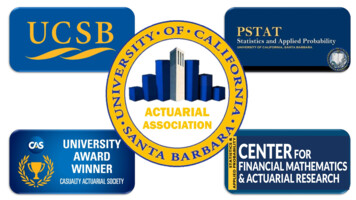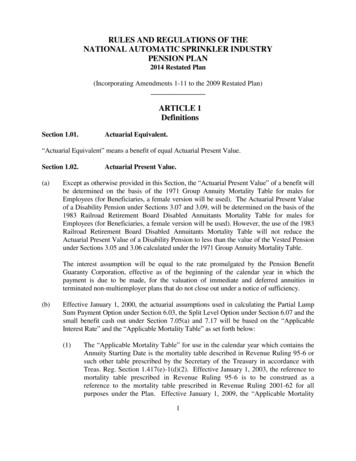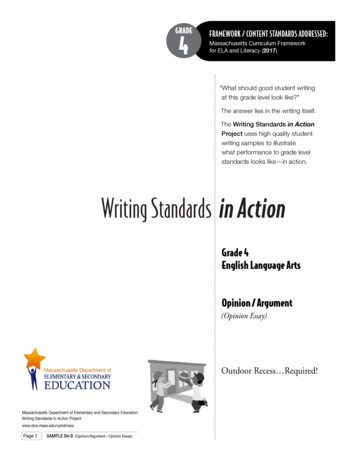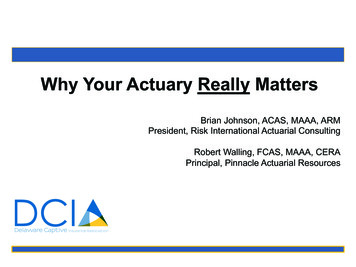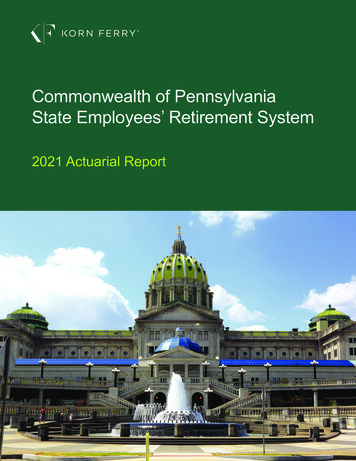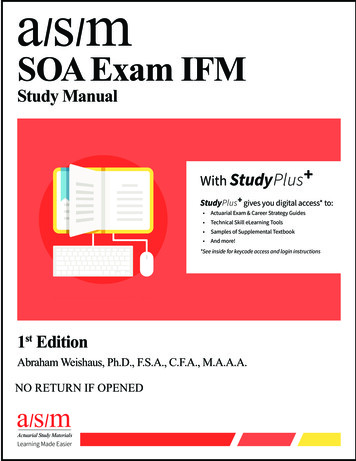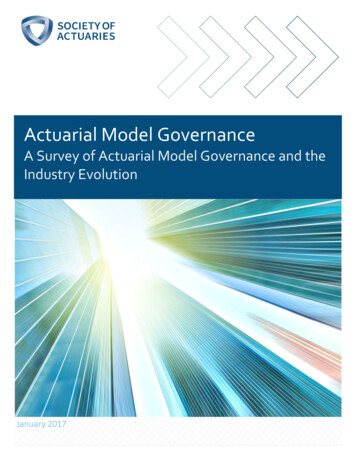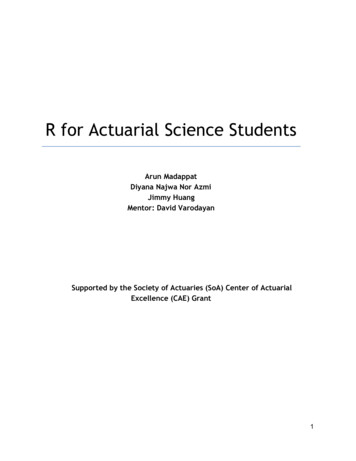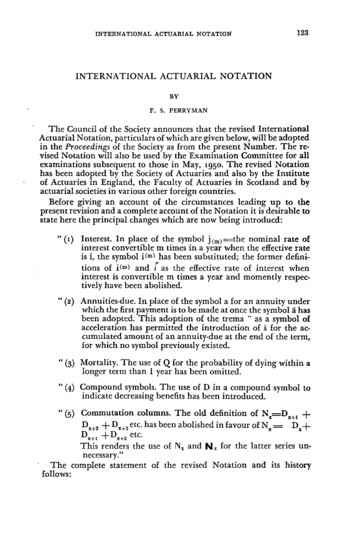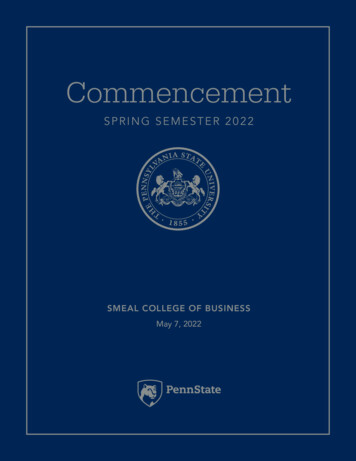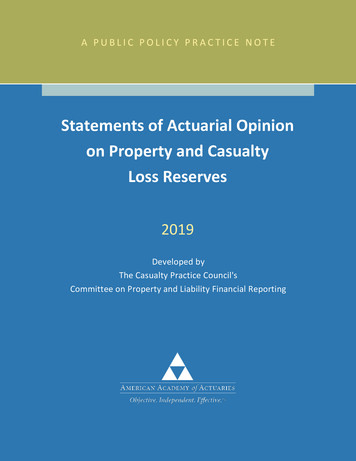
Transcription
A PUBLIC POLICY PRACTICE NOTEStatements of Actuarial Opinionon Property and CasualtyLoss Reserves2019Developed byThe Casualty Practice Council'sCommittee on Property and Liability Financial Reporting
Statements of Actuarial Opinion onProperty and Casualty LossReserves2019Developed by theCommittee on Property and Liability Financial Reportingof the American Academy of ActuariesThe American Academy of Actuaries is a 19,500 member professional association whose mission is toserve the public and the U.S. actuarial profession. For more than 50 years, the Academy has assistedpublic policy makers on all levels by providing leadership, objective expertise, and actuarial advice on riskand financial security issues. The Academy also sets qualification, practice, and professionalismstandards for actuaries in the United States.
Committee on Property and Liability Financial Reporting(2019)Kathy Odomirok MAAA, FCAS, ChairpersonDerek Freihaut MAAA, FCAS, Vice ChairpersonJohn Pierce MAAA, FCAS, FCA, Vice ChairpersonDavid Brown, MAAA, FCASJeffrey Carlson MAAA, FCASKevin Christy MAAA, FCASJanet Duncan MAAA, FSA, FCASRob Flannery MAAA, ACASBrandon Gilbert MAAA, FCASJohn Gleba MAAA, FCAS, FCALise Hasegawa MAAA, ACASBrenda Hebert MAAA, FCASDavid Heppen MAAA, FCASMichelle Iarkowski MAAA, FCASStephen Koca MAAA, FCASMelanie Leavy MAAA, FCASGeorge Levine MAAA, FCASJay Morrow MAAA, FCASJudy Mottar MAAA, FCASCarver Roya MAAA, FCASChet Szczepanski MAAA, FCASGlenn Tobleman MAAA, FCAS, FSAErnie Wilson MAAA, FCAS1850 M Street NW, Suite 300Washington, DC 20036-5805 2019 American Academy of Actuaries. All rights reserved.
Property and Casualty Practice Note2019Table of ContentsTable of Contents . 11.Introduction . 11.1What are practice notes? . 11.2Purpose of this practice note . 11.3Scope of practice note . 31.4Overview of resources . 41.5Organization of this practice note . 61.6Changes from the 2018 practice note . 72.IDENTIFICATION section . 82.1Appointment of the Qualified Actuary . 82.2Qualifications . 102.3Change in Appointed Actuary . 163.SCOPE section . 183.1Scope of SAO . 183.2Stated basis of presentation . 203.3Intercompany pooling . 213.4Review date . 233.5Provider of data relied upon by the Appointed Actuary . 253.6Evaluation of data for reasonableness and consistency . 253.7Reconciliation to Schedule P . 273.8Data testing requirement . 303.9Methodology . 334.OPINION section . 364.1Meet the relevant state laws . 374.2Accepted actuarial standards and principles . 384.3Reasonable opinion . 404.4Inadequate/deficient opinion or excessive/redundant opinion . 424.5Qualified opinion . 444.6No opinion . 464.7Other Loss Reserve items . 474.8UPR for P&C Long Duration Contracts . 494.9Other Premium Reserve items . 514.10 Use of the work of another . 525.RELEVANT COMMENTS section . 55 2019 American Academy of Actuarieswww.actuary.org
Property and Casualty Practice Note20195.1Company Specific Risk Factors . 565.2Risk of Material Adverse Deviation and the Materiality Standard . 585.3Other Disclosures in Exhibit B . 625.4Reinsurance . 785.5IRIS Ratios . 875.6Changes in methods and assumptions . 896.Additional considerations . 936.1Formatting requirements . 936.2Errors in SAOs . 967.Actuarial Opinion Summary . 987.1Filing the AOS . 997.2Content of the AOS . 1007.3Sample formats of the AOS . 1047.4AOS for pooled companies . 1067.5Errors in the AOS . 1078.Actuarial Report. 1098.1Actuarial Report requirements per the NAIC SAO Instructions . 1098.2Long-Term Care and A&H Long Duration Contracts . 1118.3Description of Appointed Actuary’s relationship to the Company . 1128.4Exhibit comparing Appointed Actuary’s conclusions to carried amounts in AnnualStatement . 1138.5Reconciling and mapping data in the Actuarial Report to Schedule P . 1148.6Exhibit and discussion on change in Appointed Actuary’s estimates . 1168.7Extended comments on risks and uncertainties . 1188.8Extended comments on unusual values for IRIS Ratio 11, 12, and/or 13 . 1199.Resources . 1209.1Applicable ASOPs . 1209.2Applicable SSAPs. 1219.3Available resources for opinions not covered by this practice note . 12210.APPENDICESI.2019 NAIC InstructionsII.I.12019 NAIC Property and Casualty SAO InstructionsI.22019 NAIC Property and Casualty AOS InstructionsI.32019 NAIC Title SAO InstructionsI.42019 NAIC Annual Statement Instructions – Excerpt Regarding Auditor DataTesting2019 AOWG Regulatory Guidance 2019 American Academy of Actuarieswww.actuary.org
Property and Casualty Practice Note2019III.Special interest topicsIII.1Unearned premium for Long Duration ContractsIII.2Intercompany poolingIII.3NAIC Guidance for Actuarial Opinions for Pools and AssociationsIII.4Retroactive and financial reinsuranceIII.5Pre-paid Loss Adjustment ExpenseIII.6Guidance for Audit Committee Members of P/C InsurersIV.SSAPsV.FAQ About Qualified Actuaries 2019 American Academy of Actuarieswww.actuary.org
Property and Casualty Practice Note20191. IntroductionThis practice note is not a promulgation of the Actuarial Standards Board, is not an actuarial standard ofpractice, is not binding upon any actuary and is not a definitive statement as to what constitutes generallyaccepted practice in the area under discussion. Events occurring subsequent to the publication of thispractice note may make the practices described in this practice note irrelevant or obsolete.This practice note was prepared by the Committee on Property and Liability Financial Reporting(COPLFR) of the Casualty Practice Council of the American Academy of Actuaries (Academy).1.1What are practice notes?The Academy’s Guidelines for Developing Practice Notes1 states:“The purpose of practice notes is to provide information to actuaries on current oremerging practices in which their peers are engaged. They are intended to supplementthe available actuarial literature, especially where the practices addressed are subject toevolving technology, recently adopted external requirements, or advances in actuarialscience and other applicable disciplines. Practice notes are not interpretations of actuarial standards of practice nor are theymeant to be a codification of generally accepted actuarial practice. Actuaries are notbound in any way to comply with practice notes or to conform their work to the practicesdescribed in practice notes.”21.1.1DiscussionPractice notes provide discussion and illustration on areas of common practice among actuaries. Eachpractice note focuses on a specific topic or application of practice.As noted in the Academy’s guidelines, practice notes are not intended to be an interpretation of theactuarial standards of practice, nor are practice notes meant to be a codification of generally accepted orappropriate actuarial practice. Actuaries are not in any way bound to comply with practice notes or toconform their work to the practices they describe.1.2Purpose of this practice noteThe purpose of this practice note is to provide information to actuaries on current practices in which theirpeers are engaged related to signing a Property and Casualty Statement of Actuarial Opinion (SAO) and12Adopted by the Academy’s Board of Directors in September 2006.Id. See ng-practice-notes.1 2019 American Academy of Actuarieswww.actuary.org
Property and Casualty Practice Note2019Actuarial Opinion Summary (AOS) as required by the National Association of Insurance Commissioners(NAIC).1.2.1DiscussionEach year COPLFR is charged with the task of updating the practicenote for SAOs on property and casualty loss reserves. The updatestypically include discussion around changes in the NAIC AnnualStatement Instructions – Property/Casualty, Actuarial Opinion (NAICSAO Instructions). Significant changes to this year’s practice note arehighlighted in yellow.1.2.2Terms of constructionFAQ: Are actuaries requiredto comply with this practicenote or follow theillustrations provided herein?A: No. The practice noteprovides information toactuaries on current andemerging practices in whichtheir peers are engaged.Actuaries are not bound in anyway to comply with practicenotes or to conform their workto the practices described inpractice notes.As with the Actuarial Standards of Practice (ASOPs) promulgated bythe Actuarial Standards Board (ASB), there are certain terms usedthroughout this practice note that are integral to an informed reading.These include “must”, “should,” and “may”. Rather than paraphrasethese definitions, we will quote the definitions as provided in ASOP No. 1, Introductory Standard ofPractice, section 2.1; these definitions are equally applicable to this practice note.“Must/Should — The words “must” and “should” are used to provide guidance in theASOPs. “Must” as used in the ASOPs means that the ASB does not anticipate that theactuary will have any reasonable alternative but to follow a particular course of action. Incontrast, the word “should” indicates what is normally the appropriate practice for anactuary to follow when rendering actuarial services. Situations may arise where theactuary applies professional judgment and concludes that complying with this practicewould be inappropriate, given the nature and purpose of the assignment and theprincipal’s3 needs, or that under the circumstances it would not be reasonable orpractical to follow the practice.Failure to follow a course of action denoted by either the term “must” or“should” constitutes a deviation from the guidance of the ASOP. In either event, theactuary is directed to ASOP No. 41, Actuarial Communications.The terms “must” and “should” are generally followed by a verb or phrase denotingaction(s), such as “disclose,” “document,” “consider,” or “take into account.” Forexample, the phrase “should consider” is often used to suggest potential courses ofaction. If, after consideration, in the actuary’s professional judgment an action is notappropriate, the action is not required and failure to take this action is not a deviationfrom the guidance in the standard.May— “May” as used in the ASOPs means that the course of action described is onethat would be considered reasonable and appropriate in many circumstances. “May” inASOPs is often used when providing examples (for example, factors the actuary may3Principal is defined in ASOP No. 1 as “a client or employer of the actuary”.2 2019 American Academy of Actuarieswww.actuary.org
Property and Casualty Practice Note2019consider; methods that may be appropriate). It is not intended to indicate that a courseof action is reasonable and appropriate in all circumstances, nor to imply that alternativecourses of action are impermissible.” 4Additionally, this practice note uses the term “required” when the course of action is required by aparticular body (e.g., the NAIC through the Annual Statement Instructions), as specified.1.3Scope of practice noteFAQ: Does the scope of thispractice note include titleinsurance opinions?According to the NAIC SAO Instructions,“There is to be included with or attached to Page 1 of theAnnual Statement, the statement of the Appointed Actuary,entitled “Statement of Actuarial Opinion” (Actuarial Opinion),setting forth his or her opinion relating to reserves specifiedin the SCOPE paragraph. The Actuarial Opinion, both thenarrative and required Exhibits, shall be in the format of andcontain the information required by this section of the AnnualStatement Instructions - Property and Casualty.”5A: While the NAIC Instructionsfor Title opinions are includedin Appendix I.3, there is noexplicit discussion around titleopinions. However, actuariesmay look to this practice notefor discussion around manytopics that are similar.This practice note is intended to assist actuaries by describing practices that COPLFR believes arecommonly employed in issuing SAOs and AOSs on loss and loss adjustment expense (LAE) reserves incompliance with the Property and Casualty Annual Statement Instructions (Annual StatementInstructions) for 2019 issued by the NAIC. Actuaries may also find this information useful in preparingstatements of actuarial opinion for other audiences or regulators.1.3.1DiscussionApproaches other than the ones described within this practice note may also be in common use. Theinformation contained in this practice note is not binding on any actuary and is not a definitive statementof what constitutes generally accepted or appropriate practice in this area.Note: Information taken from NAIC materials has been reproduced with the NAIC’s permission.Unauthorized replication or distribution of NAIC materials is strictly prohibited. COPLFR appreciates the comments it has received since the issuance of the prior year’spractice note and has incorporated a number of suggestions in this update. COPLFR alsowelcomes any suggested improvements for future updates of this practice note. Suggestions4Actuarial Standards Board, ASOP No. 1, Introductory Actuarial Standard of Practice, Section 2.1. troductoryactuarialstandardpractice/.52019 NAIC Annual Statement Instructions Property/Casualty (Appendix I.1).3 2019 American Academy of Actuarieswww.actuary.org
Property and Casualty Practice Note2019may be sent to the current chairperson of COPLFR through the Academy’s casualty policyanalyst at casualty@actuary.org.1.4Overview of resourcesThe Code of Professional Conduct (the Code) requires actuaries to “be familiar with, and keep currentwith, not only the Code, but also applicable Law and rules of professional conduct for the jurisdictions inwhich the Actuary renders Actuarial Services.” 6Appendix I.1 of this practice note provides the NAIC Annual Statement Instructions with respect to theproperty and casualty SAO and AOS. The NAIC Instructions for Title Insurance SAOs are also includedfor informational purposes only. No discussion is included.Individual states may have requirements that modify or supplement the NAIC Annual StatementInstructions. The Appointed Actuary is encouraged to refer to the Academy’s 2019 P/C Loss Reserve LawManual for guidance on these points. The 2019 P/C Loss Reserve Law Manual is available for purchasefrom the Academy.Additionally, actuaries are encouraged to carefully read and consider Regulatory Guidance on Propertyand Casualty Statutory Statements of Actuarial Opinion, Actuarial Opinion Summaries, and ActuarialReports for the Year 2019, as prepared by the NAIC’s Actuarial Opinion (C) Working Group (AOWG) ofthe Casualty Actuarial and Statistical (C) Task Force (CASTF) (hereinafter referred to as AOWGRegulatory Guidance) and included in Appendix II, the Statements of Principles adopted by the CasualtyActuarial Society (CAS)7, and other resources detailed in Chapter 9 of this practice note. Chapter 9provides a listing of the most relevant Actuarial Standards of Practice (ASOPs) and Statements ofStatutory Accounting Principles (SSAPs) that apply to the material covered by this practice note. It alsoprovides resources to actuaries providing opinions other than those covered by the scope of this practicenote. The AOWG Regulatory Guidance pertains to the 2019 SAO and the AOS and supplements theNAIC Annual Statement Instructions. The purpose is to provide timely regulatory guidance and clarity tocompanies and Appointed Actuaries regarding regulatory expectations with respect to the SAO and AOS.Note that absent a possible reference in state law or regulation, the AOWG Regulatory Guidance is notbinding.References to the AOWG Regulatory Guidance are included throughout this practice note.67American Academy of Actuaries, Code of Professional Conduct, January 1, 2001, Purpose section, last andards/princip/4 2019 American Academy of Actuarieswww.actuary.org
Property and Casualty Practice Note20191.4.1DefinitionsASB - As explained in ASOP No. 1, “The Actuarial StandardsBoard (ASB) promulgates actuarial standards of practice (ASOPs)for use by actuaries when rendering actuarial services in theUnited States. The ASB is vested by the U.S.-based actuarialorganizations8 with the responsibility for promulgating ASOPs foractuaries rendering actuarial services in the United States. Each ofthese organizations requires its members, through its Code ofProfessional Conduct9 (Code), to satisfy applicable ASOPs whenrendering actuarial services in the United States.”10CASTF - According to the NAIC website, the mission of the NAICCASTF “is to identify, investigate and develop solutions to actuarialproblems and statistical issues in the P/C insurance industry. “TheTask Force’s goals are to maintain the financial health of P/Cinsurers and to ensure that appropriate data regarding P/Cinsurance markets are available.”11AOWG – According to the NAIC website, the 2019 charges of theAOWG were: “1. Propose revisions to the following, as needed,especially to improve actuarial opinions, actuarial opinionsummaries and actuarial reports, as well as the regulatory analysisof these actuarial documents and loss and premium reserves .A. Financial Analysis Handbook.B. Annual Statement Instructions-Property/Casualty.C. Regulatory guidance to appointed actuaries andcompanies.D. Other financial blanks and instructions, as needed.FAQ: Are ASOPs binding onmembers of the U.S.-basedactuarial organizations whenrendering actuarial servicesin the U.S.?A: Yes. According to ASOP No.1, Section 1: “ASOPs arebinding on members of theU.S.-based actuarialorganizations when renderingactuarial services in the U.S.While these ASOPs arebinding, they are not the onlyconsiderations that affect anactuary’s work. Otherconsiderations may includelegal and regulatoryrequirements, professionalrequirements promulgated byemployers or actuarialorganizations, evolvingactuarial practice, and theactuary’s own professionaljudgment informed by thenature of the engagement. TheASOPs provide a basicframework that is intended toaccommodate these additionalconsiderations.”2. Based on language for the Annual Statement Instructions –Property/Casualty requiring completion of the appointed actuary’sattestation of qualification, provide additional guidance in the 2019 regulatory guidance document.” 12ASOPs - According to the ASB website, ASOPs “identify what the actuary should consider, document,and disclose when performing an actuarial assignment” and “set standards for appropriate practice for theU.S.”138The American Academy of Actuaries, the American Society of Pension Professionals and Actuaries, the Casualty ActuarialSociety, the Conference of Consulting Actuaries, and the Society of Actuaries.9These organizations adopted the Code of Professional Conduct effective January 1, 2001.10Actuarial Standards Board, ASOP No. 1, Introductory Actuarial Standard of ops/introductoryactuarialstandardpractice/ , Section 1.11http://naic.org/cmte c catf.htm12http://naic.org/cmte c act opin wg.htm13Actuarial Standards Board, ASOP No. 1, Introductory Actuarial Standard of ops/introductoryactuarialstandardpractice/ , Section 1.5 2019 American Academy of Actuarieswww.actuary.org
Property and Casualty Practice Note2019SSAPs – “Statements of Statutory Accounting Principles (SSAPs) are published by the NAIC in itsAccounting Practices and Procedures Manual. The manual includes more than 100 SSAPs, which serveas the basis for preparing and issuing statutory financial statements for insurance companies in the U.S.in accordance with, or in the absence of, specific statutes or regulations promulgated by individualstates.”141.5Organization of this practice noteEach chapter in this practice note begins with an opening paragraph describing the contents and includesan excerpt of the actual Instructions pertaining to the chapter. Separate sections within the chapterprovide details on the topic, including further quoted instruction, definitions, discussion, and illustrativelanguage. The FAQs reside with the relevant chapter/section for ease of use.The chapters are organized to facilitate use of the practice note and to align it with the structure of theSAO. Chapter 1 introduces the practice note. It is followed by four chapters (Chapter 2 through Chapter5) that line up with the four required sections of the SAO: IDENTIFICATION, SCOPE, OPINION, andRELEVANT COMMENTS (sections 3 through 6 of the Instructions). As described in the NAICInstructions,“The Actuarial Opinion must consist of an IDENTIFICATION paragraph identifying theAppointed Actuary; a SCOPE paragraph identifying the subjects on which an opinion isto be expressed and describing the scope of the Appointed Actuary’s work; an OPINIONparagraph expressing his or her opinion with respect to such subjects; and one or moreadditional RELEVANT COMMENTS paragraphs. These four Sections must be clearlydesignated.”15Chapter 6 provides additional considerations around the SAO, including filing requirements andconsiderations when the Appointed Actuary becomes aware of errors in the SAO. Chapter 7 covers theAOS and Chapter 8 covers the Actuarial Report, which is considered to be the culmination of the SAOprocess. Finally, Chapter 9 provides resources for the Appointed Actuary.The four appendices have been organized to make it easier to locate pertinent information. Appendix Iprovides the NAIC SAO and AOS Instructions, along with the excerpt of the NAIC Annual StatementInstructions regarding auditor data testing. Appendix II provides the 2019 AOWG Regulatory Guidance.Appendix III contains more detailed information about specific topics that may not be common to allSAOs. Appendix IV provides the SSAPs from NAIC’s Accounting Practices and Procedures Manualdeemed to be particularly applicable to actuaries signing NAIC property and casualty SAOs.In the Annual Statement Instructions and in this practice note, the term “loss reserves” includes LAEreserves unless specified otherwise. This follows the terminology in the NAIC Instructions.14Odomirok et al, Financial Reporting through the Lens of a Property/Casualty domirok-etal Financial-Reportingv4.pdf), CAS 2014, page 8.152019 NAIC Annual Statement Instructions Property/Casualty. Section I.1.26 2019 American Academy of Actuarieswww.actuary.org
Property and Casualty Practice Note20191.6Changes from the 2018 practice noteCOPLFR has made enhancements to the 2019 practice note based on feedback from users and athorough review by the committee. These changes include a re-organization of Chapter 5 to more closelyalign to the Instructions, additional illustrative language examples, fix minor errors, and update externalreferences to be up-to-date. COPLFR also reflected all changes to NAIC SAO and AOS Instructions,considered the updates to AOWG’s Regulatory Guidance document, and reviewed other NAIC changesthat may impact the Annual Statement as may be relevant to the work of the Appointed Actuary.Significant changes to this year’s practice note other than movement of sections related to reorganizationof Chapter 5 are highlighted in yellow.Noteworthy changes to the NAIC SAO Instructions for 2019 include: Change in the definition of “Qualified Actuary” Introduction of the term “Accepted Actuarial Designation”, which is referenced in the updateddefinition of Qualified Actuaryo Note that Exhibit B, Item 3 of the SAO (the Appointed Actuary’s designation) haschanged in response to the introduction of the term “Accepted Actuarial Designation”Introduction of qualification documentation to be submitted to the Board of the company includinga description of how the Appointed Actuary meets the definition of Qualified Actuary and theAppointed Actuary’s responsible experience relevant to the subject of the Actuarial OpinionThe 2019 AOWG Regulatory Guidance provides some background on the changes in the 2019 NAICSAO Instructions; suggests guidance to assist in creating the qualification documentation as described inthe NAIC SAO Instructions; and includes other edits to clarify the intent of changes in the 2018Instructions that resulted from the added disclosure item for Accident and Health (A&H) Long DurationContracts.7 2019 American Academy of Actuarieswww.actuary.org
Property and Casualty Practice Note20192. IDENTIFICATION sectionThis, the IDENTIFICATION chapter, is the first of four chapters (i.e., Chapter 2 through Chapter 5) in thispractice note that discuss each of the four required sections of the Statement of Actuarial Opinion:IDENTIFICATION, SCOPE, OPINION, and RELEVANT COMMENTS (sections 3 through 6 of the NAICSAO Instructions).The SAO starts with an identification paragraph, which according to the NAIC SAO Instructions should:“ indicate the Appointed Actuary’s relationship to the Company, qua
Statement Instructions - Property/Casualty, Actuarial Opinion (NAIC SAO Instructions). Significant emerging changes to this year's practice note are highlighted in yellow. 1.2.2 Terms of construction As with the Actuarial Standards of Practice (ASOPs) promulgated by the Actuarial Standards Board (ASB), there are certain terms used
